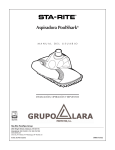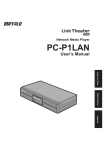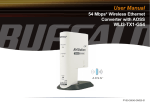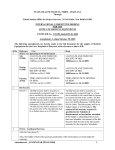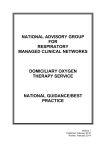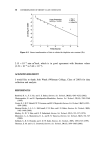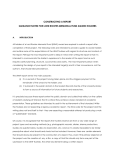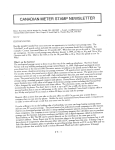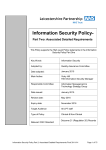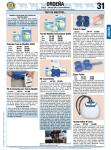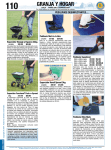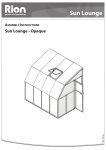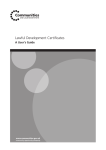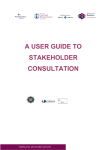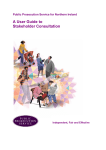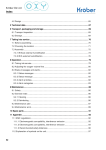Download Home Oxygen Service
Transcript
NHS FORTH VALLEY Home Oxygen Service Guideline Date of First Issue Approved Current Issue Date Review Date Version EQIA Author / Contact Group Committee – Final Approval Version 2.1 22/ 11 /2012 18/ 11 /2014 08/ 12 /2014 08/ 12 /2016 2.1 Yes 01/ 09 / 2012 Olwyn Lamont NHS Forth Valley Oxygen Steering Group December 2014 UNCONTROLLED WHEN PRINTED Consultation and Change Record – for ALL documents Contributing Authors: Clare Colligan, Antimicrobial / Clinical Governance Pharmacist Lesley Cruickshank, Lead GP, Falkirk CHP Stuart Cumming, Lead GP, Stirling CHP Glynis Gordon, Lead Nurse Clackmannanshire and Stirling CHP James King, Lead GP, Clackmannanshire CHP Catherine Labinjoh, Consultant Cardiologist Kerry Mathewson, Lead GP, Out of Hours Olwyn Lamont, Lead Respiratory Nurse Marjory Mackay, Director of Nursing, Strathcarron Hospice Laura Mackintosh, Heart Failure Specialist Nurse Douglas Morrison, Lead Respiratory Physician David Munro, MCN Manager Una MacFadyen, Consultant Paediatrician Malcolm MacLeod, Consultant Neurologist Margaret MacKinnon, Quality Improvement Facilitator Kathy O’Neill, General Manager, Forth Valley CHPs Evelyn Paterson, Palliative Care Team Leader Effie Rodger, Lead Nurse Falkirk CHP (previously) Jennifer Wilson, Lead Macmillan Lung Cancer Nurse Specialist Consultation Process: As above Distribution: NHS Forth Valley Quality Improvement Website NHS Forth Valley Intranet ‘what’s new’ NHS Forth Valley Staff Brief E-mail communication to all GPs and Lead District Nurses Change Record Date Author Change Version 24/07/2013 Olwyn Lamont Section 4.4 revised 1 24/07/2013 Olwyn Lamont Section 6 removed and changed to Oxygen Use in GP Surgeries 1 24/07/2013 Olwyn Lamont Appendix 3 – pathway updated 1 Version 2.1 December 2014 UNCONTROLLED WHEN PRINTED Table of Contents 1 2 3 4 Introduction ............................................................................................................. 4 Scope ....................................................................................................................... 4 Advisory Notes ........................................................................................................ 5 Guidance for Referral to Secondary Care for Assessment for Non-urgent Domiciliary Oxygen ................................................................................................. 7 4.1 Respiratory Specialist Assessment for Adults ....................................................... 7 4.2 Paediatric Referral ................................................................................................. 8 4.3 Cardiology Referrals .............................................................................................. 8 4.4 Palliative Referrals................................................................................................. 9 4.5 Neurology Referrals............................................................................................... 9 5 Guidance for the Initiation of Home Oxygen in Urgent Situations (9am4.30pm) and Out of Hours .................................................................................... 10 5.1 Urgent Situations (9am-4.30pm).......................................................................... 10 5.2 Urgent situations (Out of Hours) .......................................................................... 11 6 Oxygen Supplies for GP Practices ...................................................................... 12 7 Discharge from hospital ....................................................................................... 12 7.1 Non Malignant Respiratory Disease .................................................................... 12 7.2 Lung Cancer ........................................................................................................ 12 7.3 Palliative care ...................................................................................................... 13 7.4 Discharge from Strathcarron Hospice.................................................................. 13 7.5 Cardiology ........................................................................................................... 13 8 Using Oxygen Therapy ......................................................................................... 14 8.1 Safe Storage and use of Oxygen Equipment and Car Insurance ........................ 14 8.2 Transport of Oxygen Equipment on Public Transport and in a Private Vehicle .. 15 8.3 Holidays - Air Travel Insurance............................................................................ 16 9 Data Protection ...................................................................................................... 19 Appendix 1 ....................................................................................................................... 20 Appendix 1 ....................................................................................................................... 20 Appendix 2 ....................................................................................................................... 21 Appendix 3 ....................................................................................................................... 22 Appendix 4 ....................................................................................................................... 23 Appendix 5 ....................................................................................................................... 24 Appendix 6 ....................................................................................................................... 25 Version 2.1 December 2014 UNCONTROLLED WHEN PRINTED 3 1 Introduction This guidance has been adapted for local use from the national guidance/best practice document produced by the National Advisory Group for Respiratory Managed Clinical Networks. The document reflects current best practice in the assessment, review and delivery of home oxygen services. Health Facilities Scotland (HFS), a division of NHS National Services Scotland, established a National Home Oxygen Service during 2012. NHS Forth Valley has worked closely with HFS to implement a home oxygen service. The new national home oxygen service will utilise the company Dolby-Vivisol as the single oxygen supplier across Scotland and will mean a more efficient service can be provided. The move to a national supplier provides the opportunity to ensure that each patient is receiving the most appropriate care. It will ensure that future prescribing is safe and effective and support a more appropriate and efficient service. 2 Scope This guidance is aimed at all clinicians and stakeholders who may encounter people who are using home oxygen services and those requiring access to the home oxygen services in the future. The document will cover guidance for access to non urgent/planned home oxygen service, urgent oxygen (9am-4.30pm) and out of hours access. Version 2.1 December 2014 UNCONTROLLED WHEN PRINTED 4 3 Advisory Notes • There is no evidence of benefit from oxygen therapy in the absence of hypoxaemia. Significant hypoxaemia in adults requiring consideration of treatment is conventionally defined as PaO2 < 8kPa (SpO2 ≤ 92% in room air). For children the threshold for oxygen therapy varies with the diagnosis and prognosis so is defined on an individual basis. • There is no evidence to support short burst oxygen therapy (SBOT) (the use of oxygen for short periods of time for symptomatic relief in non-ambulatory circumstances). • Oxygen therapy in the absence of documented hypoxaemia should not be used as a treatment for breathlessness or anxiety. • In palliative situations, oxygen should only be considered for hypoxaemic patients who have an established diagnosis and/or who are distressed by breathlessness unrelieved by other therapy. Further information can be found in the breathlessness section of the Scottish Palliative Care Guidelines. • Oxygen is a drug and requires a prescription. The Scottish Home Oxygen Order Form (SHOOF) will be used for oxygen prescriptions and NHS Forth Valley will have designated oxygen prescribers identified (appendix 1). • Oxygen should not be prescribed for patients who continue to smoke. There may be exceptional circumstances when oxygen may be considered. For further guidance please see appendix 2. • Health Facilities Scotland recommends that E- Cigarettes should be treated in the same way as tobacco cigarettes and should not be used whilst a patient is undergoing oxygen therapy. Additionally, batteries of electronic cigarettes should not be charged in the vicinity of a patient undergoing oxygen therapy or the oxygen source itself. Version 2.1 December 2014 UNCONTROLLED WHEN PRINTED 5 • Children receiving oxygen should not be exposed to tobacco smoke and parent/carer smoking must be strongly discouraged. • Long term oxygen therapy (LTOT) should not be initiated in an out of hours setting. Version 2.1 December 2014 UNCONTROLLED WHEN PRINTED 6 4 Guidance for Referral to Secondary Care for Assessment for Non-urgent Domiciliary Oxygen 4.1 Respiratory Specialist Assessment for Adults Long Term Oxygen Therapy Confirm respiratory diagnosis. Patients should be referred for LTOT assessment when clinically stable, on optimum treatment, not smoking for > 3 months and SpO2 ≤ 92% on room air. Referrals for specialist respiratory assessment should be made via SCI-Gateway. Respiratory referrals will be vetted by a respiratory consultant and the patient will either be reviewed by a respiratory consultant or passed to a respiratory specialist nurse who will arrange a clinic visit or a home visit. If patient fits the criteria for LTOT a SHOOF will be signed by respiratory consultant, passed to HFS and Dolby-Vivisol will arrange and deliver supply. Patients will be visited at home by a respiratory nurse specialist following installation and six monthly thereafter. Dolby-Vivisol will service the oxygen concentrator on a three monthly basis. Patients with type 2 Respiratory Failure defined as a raised PaCO2 (>6.0 kPa) with associated hypoxeamia, will be issued with an oxygen alert card by the respiratory nurse specialist. The oxygen alert card alerts medical personnel and ambulance staff to the patient’s risk of type 2 respiratory failure and recommends the appropriate amount of oxygen to be given during an exacerbation. Ambulatory oxygen Ambulatory oxygen will be offered to patients established on long term oxygen therapy who require oxygen therapy to mobilise outside the home. Patients not on long term oxygen therapy who desaturate on exercise should be Version 2.1 December 2014 UNCONTROLLED WHEN PRINTED 7 referred for specialist respiratory assessment via SCI Gateway. 4.2 Paediatric Referral Children who may require long-term oxygen therapy should be considered for full assessment when clinically stable, on optimum treatment and not smoking or exposed to passive smoking. Long Term Home Oxygen Therapy (LTOT) for children should only be prescribed following assessment by an appropriately trained consultant paediatrician. In most cases the plan and arrangements for long term oxygen therapy are initiated in hospital and the Primary Care team is informed before discharge home. Occasionally a family move in to the area or a child is transferred home from a tertiary centre on oxygen when local services need to be alerted to their needs. This can be done as below, the FV paediatric respiratory team will liaise with other health professionals involved with the child or young person's care. Referrals for domiciliary oxygen for paediatric respiratory patients should be made via SCI Gateway to the Paediatric Respiratory Team. Referrals will be vetted by a paediatric consultant and the patient will be reviewed by a respiratory paediatric consultant in clinic and by a respiratory specialist nurse who will arrange a home visit. In some cases provision has to be made for LTOT in additional settings such as Nursery or school and this is arranged on an individual basis. 4.3 Cardiology Referrals Home oxygen therapy is not indicated for adult heart failure patients unless palliative, hypoxic and stable and when breathlessness is not relieved by other therapies. They should also have not been smoking for at least 3 months. Patients with left ventricular systolic dysfunction (LVSD) should be referred to the heart failure service as a cardiology referral via SCI Gateway. The patients will be reviewed by Laura Makintosh Advanced Nurse Practitioner Heart Failure. If the Version 2.1 December 2014 UNCONTROLLED WHEN PRINTED 8 patient requires home oxygen the heart failure nurse will complete SHOOF form and once home oxygen in place will visit the patient at home. Patients with other cardiology conditions e.g. non-LVSD, primary pulmonary hypertension, valvular disease should be referred to Dr Catherine Labinjoh or Dr Allister Hargreaves as a cardiology referral via SCI Gateway. Children with congenital heart disease may be prescribed home oxygen therapy by the paediatric cardiologist. The local provision is co-ordinated by the paediatric respiratory team (see section 4.2). 4.4 Palliative Referrals Breathlessness can cause significant problems in palliative care situations and treatment with oxygen may be an option. Oxygen should only be considered for hypoxaemic patients who have an established diagnosis and/or who are distressed by breathlessness unrelieved by other therapy. The patient’s SpO2 should be recorded. Please refer to the Scottish Palliative Care Guidelines. The most relevant speciality can be contacted for further advice about the best management of breathing difficulties. Please submit an urgent SCI Gateway referral and contact the department by telephone to inform the service that the referral has been made. Advice is also available from Strathcarron Hospice, particularly where the individual is already under the care of the palliative care team. Referral for consideration of oxygen provision should be made though SCI Gateway. This referral should be highlighted by telephoning the hospice to inform them that a referral has been made. 4.5 Neurology Referrals High Flow (100%) Oxygen Therapy at home for neurology patients should only be prescribed for adults or young people with a confirmed diagnosis of cluster Version 2.1 December 2014 UNCONTROLLED WHEN PRINTED 9 headache who have not been smoking for at least 3 months, and following assessment by a Consultant Neurologist or paediatric neurologist. Patients will usually have experienced rapid resolution of headache when treated with high flow oxygen in A&E or elsewhere before High Flow (100%) Oxygen Therapy at home is considered. Referrals should be sent to Neurology via SCI Gateway. Once the decision to proceed with High Flow (100%) Oxygen Therapy at home has been made the neurologist will complete SHOOF form to arrange oxygen. 5 Guidance for the Initiation of Home Oxygen in Urgent Situations (9am-4.30pm) and Out of Hours 5.1 Urgent Situations (9am-4.30pm) There may be a place for initiation of short term oxygen therapy for palliative cancer, palliative heart failure or acutely ill hypoxaemic (SpO2 ≤ 92% ) patients to reduce the likelihood of hospital admission, in particular in rural areas. This should be done with extreme caution in patients with COPD due to the possibility of aggravating Carbon Dioxide retention in those at risk of type 2 respiratory failure. Dolby-Vivisol can deliver emergency oxygen within 8 hours of receiving referral from a designated oxygen prescriber (appendix 1). However if the oxygen is required promptly during working hours the GP who has assessed the patient and made the decision to commence oxygen can access a portable concentrator. The pathway for access to portable concentrator in hours should be followed (appendix 3). The location of portable concentrators can be found in appendix 4 and for the sundries required to use with the concentrator, please see appendix 5. Oxygen should be prescribed at a rate to enable target saturations as follows • Type 1 respiratory failure (defined as PaCO2 <6kPa with associated hypoxemia): 94-98% • Type 2 respiratory failure (defined as a raised PaCO2 (>6.0 kPa) with associated hypoxeamia): 88-92% • Version 2.1 If type unknown: 88-92% December 2014 UNCONTROLLED WHEN PRINTED 10 The patient’s GP or other GP within the same Practice will be required to follow-up the patient on the next working day. The patient’s GP/ Practice is responsible for reviewing the patient’s ongoing need and considering if a referral to a specialist service if there is an ongoing need The patient’s GP/ Practice is responsible for returning the oxygen concentrator to the originating holding store/ location within the specified timescale, with the appropriate paperwork 5.2 Urgent situations (Out of Hours) Access to home oxygen out of hours can only be arranged via the Out of Hours (OOH) GP service. The patient will be assessed by the OOH GP and the decision made for home oxygen to be commenced. The pathway for access to portable concentrator OOH should be followed (appendix 6) The OOH GP will set up the oxygen concentrator and oxygen should be prescribed at a rate to enable target saturations as follows: • Type 1 respiratory failure (defined as PaCO2 <6kPa with associated hypoxemia): 94-98% • Type 2 respiratory failure (defined as a raised PaCO2 (>6.0 kPa) with associated hypoxeamia): 88-92% • If type unknown: 88-92% The patient’s GP or other GP within the same Practice will be required to follow-up the patient on the next working day. The patient’s GP/ Practice is responsible for reviewing the patient’s ongoing need, considering if a referral to a specialist service if there is an ongoing need. Version 2.1 December 2014 UNCONTROLLED WHEN PRINTED 11 The patient’s GP/ Practice is responsible for returning the oxygen concentrator to the specified location within the specified timescale, with the appropriate paperwork. 6 Oxygen Supplies for GP Practices As GPs are independent contractors, they are required to set up a contract with an oxygen provider for oxygen use within the Practice. For example British Oxygen Company or Air Liquide. 7 Discharge from hospital Patients requiring oxygen for discharge from hospital should be assessed by the relevant specialist 7.1 Non Malignant Respiratory Disease In some circumstances home oxygen maybe required for patients being discharged from hospital. Patients being considered for home oxygen should be discussed with a respiratory physician. If the decision is made that home oxygen is required this will be organised by the respiratory nurse specialist. 7.2 Lung Cancer Patients being considered for home oxygen should be discussed with a respiratory physician. If the decision is made by the respiratory physician that home oxygen maybe required for discharge home the lung cancer clinical nurse specialists will assess the patient’s suitability for home oxygen. If the decision is made to proceed with home oxygen they will complete the SHOOF form and organise the oxygen for discharge from hospital. Version 2.1 December 2014 UNCONTROLLED WHEN PRINTED 12 7.3 Palliative care Patients who are under review by the palliative care team in hospital and who are hypoxic and have not been smoking for at least 3 months, will be assessed for their suitability for home oxygen by the palliative care specialist nurses. If oxygen is required they will complete SHOOF form and organise oxygen. Patients will normally be followed up by the community palliative care nurses. 7.4 Discharge from Strathcarron Hospice Patients who are hypoxic will be assessed by the palliative care consultants and if home oxygen is required they will complete SHOOF. 7.4.1 Urgent Discharge from Strathcarron Hospice at Weekends For end of life care the portable concentrator stored at the hospice should be discharged home with the patient and the district nurse contacted who will set up the concentrator in the patient’s home 7.5 Cardiology Heart failure patients with Left Ventricular Systolic Dysfunction (LVSD) should be referred to Laura Makintosh Advanced Nurse Practitioner Heart Failure who will assess suitability for home oxygen and if required will complete SHOOF form and, once oxygen is in place, will visit at home. Patients with other cardiology conditions e.g primary pulmonary hypertension or non LVSD who are hypoxic should be discussed with either of the 2 designated cardiologist prescribers (appendix 1). Version 2.1 December 2014 UNCONTROLLED WHEN PRINTED 13 8 Using Oxygen Therapy Practical issues for prescribers/oxygen provider and users to consider 8.1 Safe Storage and use of Oxygen Equipment and Car Insurance 8.1.1 Fire Risks Consequences of oxygen enrichment: • Materials which are not flammable in air may ignite and /or burn in higher concentrations of oxygen • Materials which will burn in air will burn/ ignite at lower temperatures if the oxygen concentration is elevated 8.1.2 Prevention: Avoid oxygen enrichment by: • Turning off the equipment when not in use • Not permitting oxygen to accumulate on absorbent materials such as clothing, bedding, furniture • Keeping the user environment well ventilated 8.1.3 Flammable Materials: Do not let oxygen equipment come into contact with oils or grease, paraffin based products and NEVER use any form of lubricant (ignition is a greater risk in an oxygen enriched environment) • Do not use or store near any flammable/ oily materials • Do not cover or wipe the equipment with any fibrous material • Protect the equipment by carrying, storing and using in approved carry cases only • Wash and dry hands thoroughly before handling any oxygen equipment • Do not use or store the equipment within three metres of: Naked flames Sources of intense heat (e.g. cooker hobs, ovens, heaters etc) • Do not smoke or let others smoke near anyone while using oxygen. This not only presents a fire risk but is seriously detrimental to health • For nasal lubrication a water-based lubricant is recommended if required, for example, KY Jelly ®. 8.1.4 Physical Safety: Version 2.1 December 2014 UNCONTROLLED WHEN PRINTED 14 Avoid the risks of tripping over, or blocking the supply tubing by: • Keeping the tubing as short as is practicable, however longer tubing to allow mobility within the home may be considered following risk assessment • Using a fixed install where appropriate Responsible adults must be vigilant that other children and any animals are supervised when in the vicinity of the child on oxygen as the risk of injury exists for all. 8.1.5 Carrying / Transporting Equipment: • Use only approved devices for carriage and transport • Secure items in transit so they are not free to move 8.1.6 Toppling Over: • Ensure items are placed on a flat and robust surface where necessary to avoid overbalancing 8.2 Transport of Oxygen Equipment on Public Transport and in a Private Vehicle 8.2.1 Advice to be given to the Patient /Carer: • Only carry sufficient oxygen for the journey • Ensure you are trained in the correct method of operation of the equipment • Be aware of the appropriate precautions to be taken whilst using the oxygen equipment on public transport and in the event of an incident • Understand the risks associated with oxygen enrichment • Turn off the equipment when not in use • Ensure that the equipment is secure, not free to roll about, and where required, is supported upright • Advise patients to inform their car insurance company Version 2.1 December 2014 UNCONTROLLED WHEN PRINTED 15 8.2.2 The Oxygen Equipment should be used: • As described in the user manual • In a carrying bag to keep the cylinder / vessel secure • With the delivery tubing as short as possible • With the appropriate permission where required for use in tunnels 8.2.3 They should not: • Leave the equipment unattended • Allow anyone to tamper with the equipment • Use a humidifier • Cover the equipment with any clothing, bags or other material 8.2.4 In Private Transport, in addition to those above: • Ensure that the user and the driver are trained in the correct method of operation of the oxygen equipment • Use the equipment with the vehicle ventilation system set to draw in fresh air from outside the vehicle • Do not allow anyone to smoke in the vehicle • Do not use the oxygen equipment whilst the vehicle is being refuelled 8.2.5 Prescription and Flow Rates: The patient should be advised not to change their flow rate without consulting their clinician. Changes in flow rate must be documented as a change in prescription to allow engineers to make any necessary adjustments. 8.3 Holidays - Air Travel Insurance 8.3.1 Travel Insurance Basic travel agent holiday insurance may not be able to provide adequate cover for people with existing medical conditions. More specialised insurance policies are more suitable. It is worth shopping around for the best deals. It is important to check exactly what your cover will provide. Version 2.1 December 2014 UNCONTROLLED WHEN PRINTED 16 See the Chest Heart Stroke Scotland fact sheet ‘Sympathetic Insurance Companies’ for more information. 8.3.2 Air Travel and Oxygen Therapy There is a wide variation between different airlines in the terms and conditions under which oxygen may be carried and used. It is the customer’s responsibility to make arrangements not only for in-flight provision but also for transit and transfers within the airport(s) and on to the plane(s). There are several private oxygen providers who can facilitate this; however the costs must be met by the traveller as no provision for this service is made within the National Health Service. A Hypoxic Challenge assessment (fitness to fly assessment) should be considered in all patients receiving LTOT prior to air travel being considered. 8.3.3 All Modes of Travel (includes but not restricted to Aircraft, Trains, Cruise Ships, Ferries) Many travel agencies, airlines and other operators have dedicated help lines for customers with particular requirements. Further airline specific advice can be found here: http://www.european-lung-foundation.org/4059-europeanlung-foundation-elf-air-travel.htm Patients who use oxygen should contact their chosen travel agency/airline as soon as possible when planning any travel to establish what their policies and capabilities are. It is important that the customer: • Contacts the respective customer service department(s) to obtain a copy of their policy • Ensures that their equipment is on their list of authorised items •Obtains the necessary authorisation and has documentation in situ well in advance of the travel date Version 2.1 December 2014 UNCONTROLLED WHEN PRINTED 17 For more information about travelling with oxygen call the British Lung Foundation on 08458 50 50 20 or visit www.lunguk.org and ask for a free copy of their guide – “Going on Holiday with a Lung Condition”. Also phone the Chest Heart & Stroke Scotland Advice Line 0845 077 6000 and see the fact sheets ‘Air travel for those affected by chest heart or stroke conditions’ and ‘ Holiday Information’ or visit www.chss.org.uk 8.3.4 Holiday Supplies A patient (or by proxy, their Carer or Health Care Professional (HCP) may request a short term supply of oxygen for use on holiday within the U.K. Provided that they require oxygen modalities that are included in their original SHOOF form, and their flow rate has not changed, this supply can be made without requiring a new SHOOF form to be completed. However, should an alternative modality be requested, or a change in flow rate, a new SHOOF form should be completed by a HCP and sent to HFS. The patient should: • Provide full details of the temporary address • Provide the dates for which they require the equipment • Confirm that they have obtained permission of the owner of the property to allow the use of the equipment. This is particularly relevant if Liquid oxygen has been requested • Obtain permission from the owner to have the equipment delivered before their arrival and have it collected after their departure • CHSS produce a fact sheet ‘Holidays’ which has been compiled to provide patients and their family or carer(s), with some useful contacts to help to arrange a well-deserved break. Some organisations will make all Version 2.1 December 2014 UNCONTROLLED WHEN PRINTED 18 arrangements including travel and assistance; others will just take bookings for their own accommodation 8.3.5 Travelling with Portable Oxygen Cylinders Patients requiring portable oxygen cylinders for their holiday travel should be provided with a supply of cylinders sufficient to last the outward and return journeys. 9 Data Protection The Oxygen Therapy Service relies on the participation of third parties for effective management of its operations. The patient should be advised that: • It may be necessary to pass their details to other professionals directly involved in the provision of their healthcare and preservation of their safety • Personal information will NOT be passed to others who do not have a legitimate interest in their healthcare or their safety • Typical agencies involved in this process include, but are not restricted to: Health Facilities Scotland Dolby-Vivisol, the current service provider The client’s electricity provider in case of power failure in adverse weather conditions The local Fire and Rescue authority Child Care and Education staff Note: This is a requirement under the data protection act, and is not to be confused with gaining informed consent for treatment. Version 2.1 December 2014 UNCONTROLLED WHEN PRINTED 19 Appendix 1 NHS Forth Valley list of identified/ delegated oxygen prescribers (for home oxygen) Respiratory Consultants Dr Melanie Cross Dr Douglas Morrison Dr William Newman Dr Fraser Wood Dr Stanley Wright Dr Euan Cameron Dr Mark Spears Respiratory Specialist Nurses Olwyn Lamont Consultant cardiologists Dr Catherine Labinjoh Dr Allister Hargreaves Heart Failure Nurses Laura Mackintosh Consultant in Palliative Medicine Dr Sarah Miller Dr Till Kroeber Dr Ruth Isherwood Dr Gill Foster Hospital Palliative Care Specialist Nurses Evelyn Paterson Wilma Harley Mairi Armstrong Suzanne Nimmo Lung Cancer Specialist Nurses Theresa Thomson Jennifer Wilson Consultant Paediatricians Dr Una Macfadyen Dr Lynn MacLeod Dr Ishaq Abu-Arafeh Consultant Neurologists Professor Malcolm MacLeod Dr Katy Murray Dr Christopher Neumann Dr Suvankar Pal Version 2.1 December 2014 UNCONTROLLED WHEN PRINTED 20 Appendix 2 Smoking and oxygen therapy In general provision of home oxygen therapy for treatment of hypoxaemia without distressing symptomatic breathlessness should not be recommended for smokers. Death and serious injury to both the patient and others does occur where individuals continue to smoke in the presence of oxygen. In patients who remain distressingly symptomatic with breathlessness, yet continue to smoke despite maximal effort at smoking cessation, it may be necessary to assess the risk/ benefit of oxygen provision, discussing with the patient, family and carer. In general oxygen should not be provided in these circumstances unless the patient and carers are aware of, and clearly motivated to minimise the potential risks and the evidence of symptomatic relief is compelling. Individual risk assessment should be undertaken and clearly documented in these circumstances. Version 2.1 December 2014 UNCONTROLLED WHEN PRINTED 21 Appendix 3 Access to portable concentrators for urgent oxygen (9am-4.30pm) YES Telephone the nearest store (or another). Inform the receptionist that you need a portable oxygen concentrator Is there a portable oxygen concentrator available? District Nurse will arrange contract taxi to collect and deliver. Use cost code: V47013 NO Version 2.1 December 2014 22 UNCONTROLLED WHEN PRINTED Arrangements should be made for the return of the concentrator return to the originating holding site Appendix 4 Location of Oxygen Concentrators (for GPs to access short-term loans) for urgent home use Oxygen concentrators will be available in the following locations/ stores: In-hours (Monday to Friday 9:00am – 4:30pm) Stirlingshire • 1 will be held at St Ninian’s Health Centre • 1 will be held at Orchard House Health Centre • 1 will be held at Balfron Health Centre • 1 will be held at Callander Medical Centre Clackmannanshire • 1 will be held at Clackmannanshire Community Healthcare Centre • 1 will be held at Alva Medical Centre Falkirk District • 1 will be held at Bo’ness Health Centre • 1 will be held at Meadowbank Health Centre • 1 will be held at Denny Health Centre Telephone your local District Nursing Team to make arrangements. • 2 additional oxygen concentrators will be held in stock to backfill gaps, which will be stored at Forth Valley Royal Hospital. Contact Respiratory Nursing Department: 01324 566618 Out of Hours (via GP OOHs service only) • 1 will be held at the GP out-of-hours service at Clackmannanshire Community Healthcare Centre • 1 will be held at the GP out-of-hours service at Stirling Community Hospital • 1 will be held at the GP out-of-hours service at Forth Valley Royal Hospital Version 2.1 December 2014 UNCONTROLLED WHEN PRINTED 23 Appendix 5 Sundries The following is a list of sundries available for use with the portable concentrator. Further supplies can be obtained from Dolby-Vivisol. • • • • • Bacterial filter and tubing Adult nasal cannula Cannuala and firebreak Adult cannula with 10” supply line Adult cannula with 4” supply line Dobly-Vivisol will service the concentrator and replenish the stocks every 3 months as part of their routine service. Version 2.1 December 2014 UNCONTROLLED WHEN PRINTED 24 Appendix 6 Access to portable concentrator out of hours YES OOHs GP takes concentrator from local OOH store. Is there a portable oxygen concentrator available? The concentrator will be taken to the patient’s home by the OOH GP NO Version 2.1 December 2014 25 UNCONTROLLED WHEN PRINTED Arrangements should be made for the return of the concentrator to the original holding site Publications in Alternative Formats NHS Forth Valley is happy to consider requests for publications in other language or formats such as large print. To request another language for a patient, please contact 01786 434784. For other formats contact 01324 590886, text 07990 690605, fax 01324 590867 or e-mail - [email protected] Version 2.1 December 2014 UNCONTROLLED WHEN PRINTED 26



























